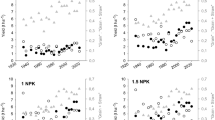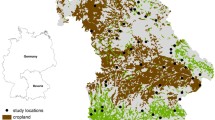Abstract
The collapse of Soviet Union in early 1990s led to abandonment of large area of arable land which is assumed to act as a carbon (C) sink. We studied the ability of two dynamic soil C models (Yasso07 and RothC) to predict changes in soil C content after cropland abandonment. The performance of the models was compared using the results of a long-term experiment in Pushchino, Moscow region (54°50′N, 37°35′E) in Russia. The experiment was divided in four combinations of fertilizer or mowing treatments on former cropland soil. The soil C content was determined in the year of establishment (1980) and thereafter in 1999 and 2004. The soil C stocks increased by about 1.5- to 1.8-fold during the study period. Both models predicted the overall change in soil C relatively well (modelling efficiency of Yasso07 and RothC were 0.60 and 0.73, respectively). According to the models, the soil gained on average 140–150 g C m−2 year−1 during the first 5 years after conversion of cropland to grassland. The C sequestration rate decreased to 40–50 g C m−2 year−1 after 20 years of land use change. The sequestration rates estimated in this study are comparable to the rates observed in other studies.




Similar content being viewed by others
References
Allen RG, Pereira LS, Raes D, Smith M (1998) Crop evapotranspiration—guidelines for computing crop water requirements-FAO Irrigation and drainage paper 56. FAO, Rome 300: 6541
Bolinder MA, Janzen HH, Gregorich EG, Angers DA, VandenBygaart AJ (2007) An approach for estimating net primary productivity and annual carbon inputs to soil for common agricultural crops in Canada. Agric Ecosyst Environ 118:29–42
Canadell J, Jackson R, Ehleringer J, Mooney H, Sala O, Schulze ED (1996) Maximum rooting depth of vegetation types at the global scale. Oecologia 108:583–595
Coleman K, Jenkinson D (1999) ROTHC-26.3. A model for the turnover of carbon in soil. IACR-Rothamsted, Harpenden
Don A, Scholten T, Schulze E (2008) Conversion of cropland into grassland: implications for soil organic-carbon stocks in two soils with different texture. J Plant Nutr Soil Sci 172:53–62
Falloon P, Smith P (2002) Simulating SOC changes in long-term experiments with RothC and CENTURY: model evaluation for a regional scale application. Soil Use Manag 18:101–111
FAO (2006) World reference base for soil resources 2006: a framework for international classification, correlation and communication. World soil resource reports 103. Rome
Farina R, Coleman K, Whitmore AP (2013) Modification of the RothC model for simulations of soil organic C dynamics in dryland regions. Geoderma 200:18–30
Gaiser T, Abdel-Razek M, Bakara H (2009) Modeling carbon sequestration under zero-tillage at the regional scale. II. The influence of crop rotation and soil type. Ecol Model 220:3372–3379
Goidts E, Van Wesemael B, Crucifix M (2009) Magnitude and sources of uncertainties in soil organic carbon (SOC) stock assessments at various scales. Eur J Soil Sci 60:723–739
Guo LB, Gifford RM (2002) Soil carbon stocks and land use change: a meta analysis. Glob Change Biol 8:345–360
Hargreaves GH (1994) Defining and using reference evapotranspiration. Journal of Irrigation and Drainage Engineering 120:1132–1139
Haylock M, Hofstra N, Tank AMGK, Klok E, Jones P, New M (2008) A European daily high-resolution gridded data set of surface temperature and precipitation for 1950–2006. J Geophys Res 113:D20119
Jackson R, Canadell J, Ehleringer J, Mooney H, Sala O, Schulze E (1996) A global analysis of root distributions for terrestrial biomes. Oecologia 108:389–411
Janssen P, Heuberger P (1995) Calibration of process-oriented models. Ecol Model 83:55–66
Jobbágy EG, Jackson RB (2000) The vertical distribution of soil organic carbon and its relation to climate and vegetation. Ecol Appl 10:423–436
Karhu K, Wall A, Vanhala P, Liski J, Esala M, Regina K (2011) Effects of afforestation and deforestation on boreal soil carbon stocks—comparison of measured C stocks with Yasso07 model results. Geoderma 164:33–45
Karhu K, Gärdenäs AI, Heikkinen J, Vanhala P, Tuomi M, Liski J (2012) Impacts of organic amendments on carbon stocks of an agricultural soil—comparison of model-simulations to measurements. Geoderma 189–190:606–616
Kurganova I, Yermolaev A, Lopes de Gerenyu V, Larionova A, Kuzyakov Y, Keller T, Lange S (2007) Carbon balance in the soils of abandoned lands in Moscow region. Eur Soil Sci 40:51–58
Kurganova IN, Lopes de Gerenyu VO, Myakshina TN, Sapronov DV, Lichko VI, Yermolaev AM (2008) Changes in carbon stocks of former croplands in Russia. Žemės Ūkio Mokslai 15:10–15
Kurganova I, Kudeyarov V, Lopes De Gerenyu V (2010a) Updated estimate of carbon balance on Russian territory. Tellus B 62:497–505
Kurganova I, Lopes de Gerenyu V, Shvidenko A, Sapozhnikov P (2010b) Changes in the organic carbon pool of abandoned soils in Russia (1990–2004). Eur Soil Sci 43:333–340
Kurganova I, Lopes de Gerenyu V, Six J, Kuzyakov Y (2013) Carbon cost of collective farming collapse in Russia. Global Change Biol. doi:10.1111/gcb.12379
Kuzyakov Y, Domanski G (2000) Carbon input by plants into the soil. Review. J Plant Nutr Soil Sci 163:421–431
Lal R (2004) Agricultural activities and the global carbon cycle. Agricultural activities and the global carbon cycle. Nutr Cycl Agroecosyst 70:103–116
Larionova A, Rozanova L, Yevdokimov I, Yermolayev A, Kurganova I, Blagodatsky S (2003) Land-use change and management effects on carbon sequestration in soils of Russia’s South Taiga zone. Tellus B 55:331–337
Larionova A, Zolotareva B, Yevdokimov I, Sapronov D, Kuzyakov Ya, Buegger F (2008) The rates of organic matter renewal in gray forest soils and Chernozems. Eur Soil Sci 41(13):1378–1386
Larionova A, Yermolaev A, Nikitishen V, Lopes de Gerenyu V, Evdokimov I (2009) Carbon budget in arable gray forest soils under different land use conditions. Eur Soil Sci 42:1364–1373
Liski J, Lehtonen A, Palosuo T, Peltoniemi M, Eggers T, Muukkonen P, Mäkipää R (2006) Carbon accumulation in Finland’s forests 1922–2004—an estimate obtained by combination of forest inventory data with modelling of biomass, litter and soil. Ann For Sci 63:687–697
Loague K, Green RE (1991) Statistical and graphical methods for evaluating solute transport models: overview and application. J Contam Hydrol 7:51–73
Lobe I, Bol R, Ludwig B, Du Preez CC, Amelung W (2005) Savanna-derived organic matter remaining in arable soils of the South African Highveld long-term mixed cropping: evidence from 13 C and 15 N natural abundance. Soil Biol Biochem 37:1898–1909
Lopes de Gerenyu V, Kurganova I, Kuzyakov Y (2008) Carbon pool and sequestration in former arable Chernozems depending on restoration period. Ecologija 54:232–238
Lyuri D, Goryachkin S, Karavaeva N, Denisenko E, Nefedova T (2010) Dynamics of agricultural lands of Russia in XX century and postagrogenic restoration of vegetation and soils. Moscow, Geos, 410 p
Olff H, Van Andel J, Bakker J (1990) Biomass and shoot/root allocation of five species from a grassland succession series at different combinations of light and nutrient supply. Funct Ecol 4:193–200
Orlov D, Grishina L (1981) Manual for humus chemistry. Moscow University Publish, Moscow (in Russian)
Ortiz CA, Liski J, Gärdenäs AI, Lehtonen A, Lundblad M, Stendahl J, Ågren GI, Karltun E (2013) Soil organic carbon stock changes in Swedish forest soils—a comparison of uncertainties and their sources through a national inventory and two simulation models. Ecol Model 251:221–231
Peltoniemi M, Thürig E, Ogle S, Palosuo T, Schrump M, Wutzler T, Butterbach-Bahl K, Chertov O, Komarov A, Mikhailov A (2007) Models in country scale carbon accounting of forest soils. Silva Fennica 41:575
Poeplau C, Don A (2013) Sensitivity of soil organic carbon stocks and fractions to different land-use changes across Europe. Geoderma 192:189–201
Poeplau C, Don A, Vesterdal L, Leifeld J, Van Wesemael B, Schumacher J, Gensior A (2011) Temporal dynamics of soil organic carbon after land-use change in the temperate zone- carbon response functions as a model approach. Glob Change Biol 17:2415–2427
Poeplau C, Don A, Dondini M, Leifeld J, Nemo R, Schumacher J, Senapati N, Wiesmeier M (2013) Reproducibility of a soil organic carbon fractionation method to derive RothC carbon pools. Eur J Soil Sci 64:735–746
Post WM, Kwon KC (2008) Soil carbon sequestration and land-use change: processes and potential. Glob Change Biol 6:317–327
Repo A, Känkänen R, Tuovinen JP, Antikainen R, Tuomi M, Vanhala P, Liski J (2011) Forest bioenergy climate impact can be improved by allocating forest residue removal. GCB Bioenergy 4:202–212
Romanovskaya A (2006) Organic carbon in long-fallow lands of Russia. Eur Soil Sci 39:44–52
Russia in figures (2012) Rosstat, Moscow. http://www.gks.ru/bgd/regl/b12_12/IssWWW.exe/Stg/d01/15-12.htm. Accessed 2 July 2013
Schierhorn F, Muller D, Beringer T, Prishchepov AV, Kuemmerle T, Balmann A (2013) Post-Soviet cropland abandonment and carbon sequestration in European Russia, Ukraine and Belarus. Global Biogeochem Cycles. doi:10.1002/2013/GB004654
Shirshova LT, Yermolaev AM (1990) Peculiarities of humus accumulation at grassing of arable gray forest soil. Zh Obshch Biol 51(5):642–650 (in Russian)
Smith J, Smith P, Monaghan R, MacDonald A (2002) When is a measured soil organic matter fraction equivalent to a model pool? Eur J Soil Sci 53:405–416
Smith J, Smith P, Wattenbach M, Zaehle S, Hiederer R, Jones RJA, Montanarella L, Rounsevell MDA, Reginster I, Ewert F (2005) Projected changes in mineral soil carbon of European croplands and grasslands, 1990–2080. Glob Change Biol 11:2141–2152
Smith J, Smith P, Wattenbach M, Gottschalk P, Romanenkov V, Shevtsova L, Sirotenko O, Rukhovich D, Koroleva P, Romanenko I (2006) Projected changes in the organic carbon stocks of cropland mineral soils of European Russia and the Ukraine, 1990–2070. Glob Change Biol 13:342–356
Soil Survey Division Staff (1993) Soil survey manual. United States Department of Agriculture, 315 p
Tuomi M, Thum T, Järvinen H, Fronzek S, Berg B, Harmon M, Trofymow JA, Sevanto S, Liski J (2009) Leaf litter decomposition—estimates of global variability based on Yasso07 model. Ecol Model 220:3362–3371
Tuomi M, Rasinmäki J, Repo A, Vanhala P, Liski J (2011) Soil carbon model Yasso07 graphical user interface. Environ Model Softw 26:1358–1362
Van Wesemael B, Paustian K, Meersmans J, Goidts E, Barancikova G, Easter M (2010) Agricultural management explains historic changes in regional soil carbon stocks. Proc Natl Acad Sci 107:14926–14930
Vuichard N, Ciais P, Belelli L, Smith P, Valentini R (2008) Carbon sequestration due to the abandonment of agriculture in the former USSR since 1990. Global Biogeochem Cycles 22:GB4018
Weihermueller L, Graf A, Herbst M, Vereecken H (2013) Simple pedotransfer functions to initialize reactive carbon pools of the RothC model. Eur J Soil Sci 64:567–575
West TO, Marland G, King AW, Post WM, Jain AK, Andrasko K (2004) Carbon management response curves: estimates of temporal soil carbon dynamics. Environ Manage 33:507–518
Yermolaev AM, Shirshova LT (1994) Productivity and functioning of a perennial sown meadow of various management type. Pochvovedenie 12:97–105 (in Russian)
Yermolaev A, Shirshova L (2000) Influence of weather conditions and management of a sown meadow on the herbage productivity and properties of gray forest soils. Eur Soil Sci 33:1321–1328
Zimmermann M, Leifeld J, Schmidt M, Smith P, Fuhrer J (2007) Measured soil organic matter fractions can be related to pools in the RothC model. Eur J Soil Sci 58:658–667
Acknowledgments
We are grateful to Dr. Alla Larionova and Dr. Alexander Yermolaev for their collaboration in different phases of the study. We acknowledge Dr. Vera Ableeva (the Station of Background Monitoring, Danki, Moscow region) and the ECAD project (http://www.ecad.eu) for providing climate data. An anonymous reviewer helped us to improve the manuscript. The study was funded by the Ministry of Agriculture and Forestry via the AgriYasso-Project, Russian Foundation for Basic Research (Projects 12-05-00197a, 12-04-00201a) and The Emil Aaltonen Foundation. Maa- ja vesitekniikan tuki ry and Academy of Finland funded the travelling costs.
Author information
Authors and Affiliations
Corresponding author
Rights and permissions
About this article
Cite this article
Heikkinen, J., Kurganova, I., Lopes de Gerenyu, V. et al. Changes in soil carbon stock after cropland conversion to grassland in Russian temperate zone: measurements versus model simulation. Nutr Cycl Agroecosyst 98, 97–106 (2014). https://doi.org/10.1007/s10705-014-9599-8
Received:
Accepted:
Published:
Issue Date:
DOI: https://doi.org/10.1007/s10705-014-9599-8




